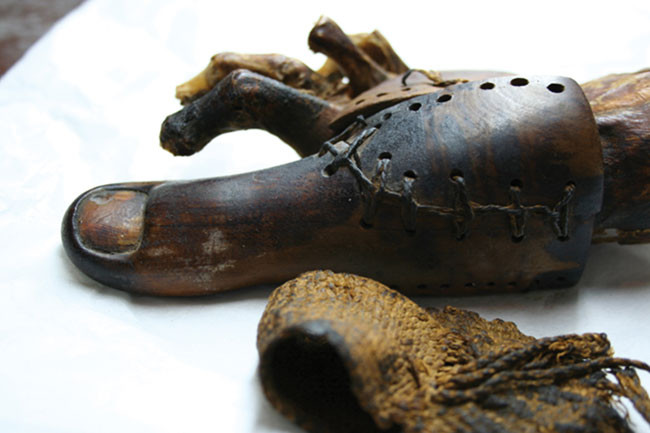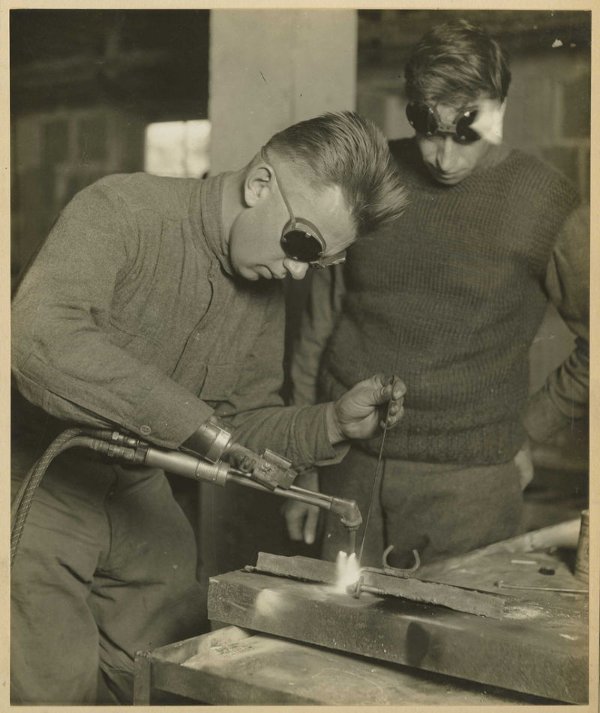History of making artificial limbs in the world
Over time, prosthetics are not only designed to replace lost parts, but also help people perform many jobs in everyday life.
Birth history of artificial limbs
Researchers believe that the earliest prosthetics in the world are two artificial toes from ancient Egypt . Prosthetic devices were primarily made for decoration, but artificial toes in Egypt are the earliest evidence of the functioning of a prosthetic device.

Finger from ancient Egypt may be one of the first prosthetics in the world.(Photo: Jacky Finch).
According to Dr. Jacky Finch of the University of Manchester, England, prosthetics today are produced after studying each person's gait. In the study, Finch selected two volunteers to try on these two patterns and was surprised to learn that they were comfortable.
"My findings indicate that both of these designs can work to replace lost toes, and so are classified as fake limbs," he said.
The iron limb of the German knight Gotz von Berlichingen (1480-1562), who served the Roman Emperor of the Roman Empire, could operate through articulation. This type is often expensive, but allows people who lose spending to continue working. Articulated fingers are used to secure the shield, hold the reins tight or even a brush. The division for von Berlichingen was manufactured by a specialist in manufacturing weapons.
Centuries later, the number of people injured in the American Civil War prompted the demand for prosthetic parts to skyrocket. Many veterans also design their own products.

Since the end of World War II, fake hand designs allow people to do previous jobs that are thought to be impossible to weld or drive.(Photo: National Museum of Health and Medicine).
James Hanger, one of the first to be amputated in this war, was patented with the Limb Hanger design. Another is Samuel Decker, who also designed the artificial arm and became a pioneer in the design of modular limbs.
Around 1900, pioneering genius designers began the idea of creating specialized prosthetics, not just for decoration. A good example is the artificial arm for a pianist who performed at London's Royal Albert Hall in 1906. The fake hand has extended fingers; index finger, middle finger and ring finger are smaller than usual; Thumbs and pinkie are padded.
Prosthetic limbs were mass-produced for the first time in World War I. In the United States, Walter Reed Army Hospital produced large quantities for veterans returning from the war. Welding hooks and a number of other tools are attached to the prosthetic hand, helping them work and start a new life.
The artificial hands had hooked up with DW Dorrance before World War I and became popular with post-war workers, when they could use them to grasp and adjust things. This is one of the few designs that has changed little in the past century. In the 1930s, Dorrance proved the versatility of this prosthetic hand when driving it.

Technology development, fake hands are designed more and more specialized.(Photo: Wikimedia).
Queen Mary Hospital in England became the center of prosthetic production during World War II, beginning in 1939. In the first year alone, 10,987 people received war aid came here and 16,251 prosthetic parts. Sending through post office. The plant expanded its scope of operation when the war broke out, because they thought that about 40,000 British soldiers lost their limbs during World War I.
However, this figure in World War II is only half that. Techniques for treating infections, advanced surgical methods and available blood levels have reduced the number of people who have to cut their legs or arms.
- Artificial Neuralgia delivers life for prosthetic limbs
- The world's first artificial biologist
- Feeling of artificial touch
- Why are limbs cold in winter?
- Artificial intelligence: Development history and future potential
- Artificial skin feels real
- Embryo fossils
- How to help you avoid hateful numbness
- Artificial leaves produce energy from polluted water
- The 40 most talented geniuses in human history (Part 3)
- The fake hand will feel like a real hand thanks to this new system
- Appeared artificial rattan making machine in China
 Biography of hero Vu A Dinh
Biography of hero Vu A Dinh History of hematology
History of hematology Who is Mr. Tam Da 'Phuc-Loc-Tho' and what does it mean?
Who is Mr. Tam Da 'Phuc-Loc-Tho' and what does it mean? Unbelievable facts about the history of the oil and gas industry: Gasoline used to be cheaper than water, so abundant that it had to be dumped into the river...
Unbelievable facts about the history of the oil and gas industry: Gasoline used to be cheaper than water, so abundant that it had to be dumped into the river...